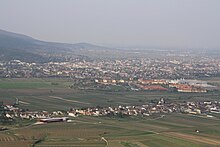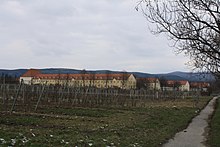Martinek barracks

The Martinek barracks is a former barracks of the Austrian Armed Forces in Baden near Vienna in Lower Austria. The barracks area on the B 212 extends over the municipal areas of Sooss and Baden. It has not been used for military purposes since December 31, 2013. The subsequent use is in the discussion phase.
history
After the occupation of Austria by the Wehrmacht , a unit of the protection police first moved into accommodation in Baden. Instead of the planned larger flak divisions , a smaller flak division from Bavaria was quartered in the Hotel Brusatti on March 14, 1938 . Three weeks later, one of Colonel Job Odebrecht (1892–1982) commanded an advance command of the 25th Flak Regiment came into the city. On April 24th of that year the negotiations (conducted with Luftgaukommando XVII ) on the huge land purchases (30 hectares , 8 of them on Soosser parish ground) were concluded in the town hall of Baden . The work planned by the Austrian architect Leo Splett (1908–1993) began in May 1938 without the groundbreaking ceremony, but at the Vöslauerstraße construction site encouraged by words of the inspecting Field Marshal Hermann Göring . The construction project, which was designed for a workforce of 2,000, was completed in June 1941, whereby ten percent (28,000 m³ of enclosed space ) of the entire project could not be realized, especially because of the outbreak of war.
The one to two-storey buildings, at right angles to each other, usually have (partially expanded) gable roofs . In the northeast of the built-up barracks area, closest to the command building, is the segmented main entrance.
At the end of the war, the SA had planned to blow up the barracks . However, various fuses could be cut by a Baden freedom fighter employed in the flak barracks, so that detonations triggered only resulted in relatively minor destruction .
The extensive complex of numerous building complexes was a base of the Soviet occupation from 1945-55 . After it was returned in 1955, there were two possible uses: a large hospital and a school town. However, a decision was made in favor of the ancestral dedication: On March 15, 1956, School Battery 2 moved into the Baden Artillery Barracks (official name 1956-63) as advance command, which was followed by the Artillery Troop School on April 12 of that year . In 1957 a motor vehicle sergeant school was set up, and in 1962/63 the PzAB 9 tank artillery battalion moved in . On June 28, 1963, together with the unveiling of a memorial plaque, the barracks were named after the artillery general Robert Martinek (1889–1944).
Since it was used by the Austrian Armed Forces , the barracks formed its own garrison . In addition, the Baden / Military Command Burgenland sanitary facility had been housed in the complex since 1969, providing outpatient and clinical care to basic military servants and staff from the surrounding barracks in the northern industrial district and Burgenland .
With around 400 employees who are on duty here alongside the basic military service, the armed forces were one of the largest employers in the city of Baden.
Defense Minister Günther Platter's plans were for the barracks to be closed in 2008. Studies and dedication plans for later use of the large area, such as schools, were also worked out. Parts of the facility are under monument protection .
Contrary to the plan to close the barracks in 2008, a sale was further delayed as there was less and less bid for the facility (as a whole). In 2009, with 650 soldiers, more crew was accommodated than ever before. Since 2009 a sale (or preparation for sale) has been under discussion for 2012, possibly also continued military use until 2015.
In April 2013, the Federal Ministry of Defense and Sport announced the final closure of the barracks for the end of 2013. The city of Baden has considered the establishment of a hi-tech, research and production campus for the vacant property - not a complete rededication of land in private building land. Most of the military equipment was moved to the Burstyn barracks in Zwölfaxing.
On November 19, 2014, the barracks were offered for sale on the online advertising platform Willhaben for 33.1 million euros. At the beginning of 2017, the barracks were put up for sale again.
See also
Web links
literature
- Viktor Wallner : From the headquarters to the congress casino. 50 years of bathing in data and images. 1945-1995 . New Badener Blätter, entertaining and interesting facts from the spa town of Baden near Vienna, Volume 6.1, ZDB -ID 2161928-1 . Publishing house of the Society of Friends of Baden and the Municipal Collections, Baden 1993 (?).
- Herbert Hofinger (editor), Otto E. Plettenbacher (collaboration): 40 years of Martinek barracks in Baden. 1956 - 1996. Festschrift . Edited and published by: BMLV , Kommando III. Corps, Baden 1996.
- Viktor Wallner: Houses, people and stories - a Baden anecdotal walk . Society of Friends of Baden, Baden 2002.
- Rudolf Maurer: “Liberation? - Liberation! Baden 1945–1955 ” . Catalog sheets of the Rollettmuseum Baden, Volume 55, ZDB -ID 2101396-2 . Rollettmuseum, Baden 2005, ISBN 3-901951-55-5 .
Individual evidence
- ↑ Baden: Playground instead of barracks courtyard on ORF from January 10, 2014, accessed on January 10, 2014
- ↑ a b Wallner: Häuser , p. 179.
- ↑ Rescue from the economic crisis: huge land purchases for the barracks. In: Badener Zeitung , No. 34/1938 (LIX. Volume), April 27, 1938, p. 3. (Online at ANNO ). .
- ↑ Field Marshal General Hermann Göring in Baden. In: Badener Zeitung , No. 39/1938 (LIX. Volume), May 14, 1938, p. 1. (Online at ANNO ). .
- ↑ Field Marshal Göring in the Baden district. Cheers for the Marshal of the Empire. In: Badener Zeitung , No. 40/1938 (LIX. Volume), May 18, 1938, p. 1 f. (Online at ANNO ). .
- ↑ Peter Aichinger-Rosenberger (among others): Lower Austria south of the Danube. Band 1: A to L . Dehio-Handbuch , Die Kunstdenkmäler Österreichs, topographic monuments inventory. Berger, Horn / Wien 2003, ISBN 3-85028-364-X , p. 220.
- ↑ Maurer: “Liberation? - Liberation! " , P. 63.
- ↑ a b c Wallner: Häuser , p. 180.
- ^ Wallner: From the commandant's office to the congress casino , p. 20.
- ^ Wallner: Von der Kommandantur zum Kongresscasino , p. 27.
- ↑ Use concept of the Martinek barracks in Baden HTL-Innovativ Austria, accessed on February 13, 2010.
- ^ Martinek barracks: sale planned for 2012 (...) . In. orf.at , May 3, 2009, accessed May 14, 2012.
- ^ Baden: barracks are locked and sold . In: noe.orf.at , April 25, 2013, accessed on August 22, 2013.
- ↑ Baden is planning "Silicon Valley" . In: noe.orf.at , June 2, 2013, accessed on August 22, 2013.
- ↑ Kaserne closes after 70 years on ORF from September 21, accessed on September 22, 2013
- ↑ derStandard.at - Federal Army sells barracks on willhaben.at . Article in the Standard of November 20, 2014, retrieved on November 21, 2014.
- ↑ Martinek Kaserne on willhaben.at ( Memento from November 21, 2014 in the web archive archive.today )
- ↑ orf.at - Martinek barracks advertised again . Article from January 12, 2017, accessed on January 12, 2017.
Remarks
- ↑ a b Baden, Kaiser-Franz-Joseph-Ring 15; Canceled in the late 1960s.
- ↑ In the media reports on property sales and tenders, 40 ha are usually mentioned.
Coordinates: 47 ° 59 ′ 32.7 ″ N , 16 ° 13 ′ 27 ″ E


